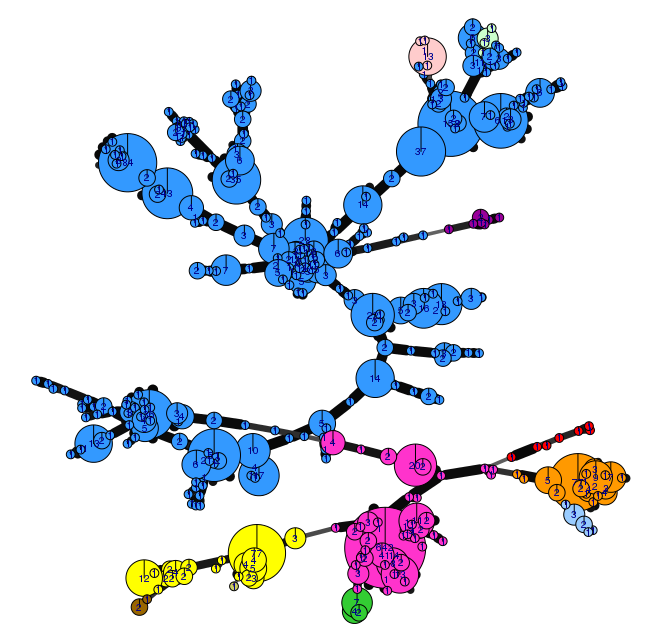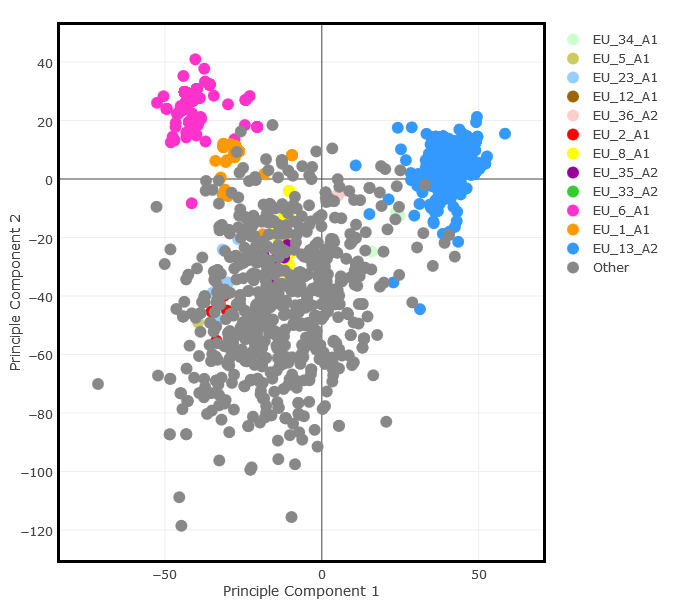Potato blight tracking in Europe - 2013-2015
A team of researchers tracking the 2015 population of the potato late blight pathogen have added to the 2013 and 2014 data to provide three years of data on the spatial pattern of pathogen genetic diversity that visualises the distribution and diversity of dominant clones and reveals novel genetically diverse isolates in some regions.

Since its arrival in the nineteenth century, Phytophthora infestans, the cause of late blight has remained a serious threat to potato crops. Although we are now better equipped to control the disease than in the past, an evolving pathogen population continues to challenge our management practices. Rapid changes in P. infestans populations causing late blight in Europe, America and Asia, including the emergence of strains with altered pathogenicity or reduced fungicide sensitivity have been observed. We have been monitoring populations and characterising the invasive genotypes to help optimise IPM strategies, as required by EU Directive 2009/128/EC on the sustainable use of plant protection products. The changes in P. infestans populations directly influence the development and deployment of resistant cultivars, the performance of disease warning systems and the efficacy of plant protection products. Coordinated and continuous pathogen monitoring was proposed by the EuroBlight consortium at its meeting in 2013. Here, researchers in the Netherlands, Scotland Denmark and France, working with partners from research labs and industry, present their third report on its pathogen monitoring in potato crops in 2015.
As in previous years ‘FTA cards’ were distributed to disease ‘scouts’ from across the industry who visited blight-infected crops. Disease lesions were pressed on the cards and returned to the laboratories where the pathogen DNA was fingerprinted at Wageningen University and Research Centre, the James Hutton Institute and INRA, Rennes. The DNA fingerprint data was used to define the clonal lineages of the pathogen and combined with geo-location data to plot the diversity across Europe. Disease pressure was generally low in 2015 which restricted the sample distribution. However, over 600 samples were genotyped from across 16 European countries. This data also includes that from the AHDB Potatoes ‘Fight Against Blight’ campaign in Great Britain. The data from 2013-2015 comprise over 2800 samples from 30 countries.
The pattern of P. infestans diversity across Europe in 2015 was similar to the two preceding seasons. In each year 70 to 79% of the population comprised known clonal lineages that recur each season. The remaining samples were novel, genetically diverse genotypes found at a single location in one season and grouped in a category termed ‘Other’ (Figure 1). In 2015 the EU_13_A2 (blue-13) clone made up 39% of the population and was present in 11 countries. It was also found in Turkish crops that were sampled for the first time in 2015. In 2013 and 2014 it made up 38 and 37% of the population and has been reported in 23 European countries. The second most prevalent clone, EU_6_A1, was found at 19, 32 and 22% frequency in 2013, 2014 and 2015, respectively but in only eight countries and, in general, restricted to France, Belgium and the UK. The clone EU_1_A1 has increased from around 3 to 7.8% of the population over this study and 90% of the occurrences were in Belgium and France. |  |
|---|---|
Figure 1. Genotype map, 2015 sampling. Go to live map. |
A new genotype, found 17 times in the Netherlands and Germany in 2014 and 2015 was defined as clone EU_36_A2. This is another in a series of triploid clones (like 13_A2 and 6_A1) and is thus of potential concern. No data is yet available on its traits but it will be tested in 2016. The genetically diverse ‘Other’ samples comprised 30, 21 and 28% of the population in 2013, 2014 and 2015, respectively. Although found in many regions they were at the highest frequency in the east and north-east of Europe. In contrast to the clonal types, the traits possessed by these isolates are not well understood. However, a recently funded ERA-NET project (http://euroblight.net/research-projects/ipmblight20) is beginning a detailed study of the traits of clonal and sexually recombinant isolates to help improve late blight management.
 | Detailed analysis of the genetic diversity is now possible via a novel link between an analysis tool (POPPR) and the pathogen database (Fig. 2). A principal component analysis of samples coloured by clone indicates grey ‘Other’ genetically diverse isolates compared to the tight clusters of limited diversity within the dominant clonal types. More detailed analysis is underway to examine population change using these methods.This model of pathogen tracking offers a rapid, cost-effective and co-ordinated approach to understanding pathogen evolution on a European scale. Data on the dominant clones has been passed to growers, advisors, breeders and agrochemical companies to provide practical management advice and shape longer-term strategies. Furthermore, early warning of newly evolved clones will enable a timely response from the industry. |
|---|
Figure 2. Genetic diversity analysis of all 2800 samples. |
The Euroblight network is in discussion with other networks in the Americas and Asia and encourages continued co-operation between groups involved in managing late blight to exploit the database and tools for improved awareness and blight management on a global scale.
We will continue the project in 2016 so please make contact with the project team if you would like more information. We thank all the partners who have contributed to the funding and data collection.
Companies and institutions that participated in the sampling and sponsored the project
ADAMA, AFBI, Agrifirm, Agriphar, AFBI, AHDB Potatoes, BASF SE, Bayer CropScience AG, Bayerische Landesanstalt für Landwirtschaft, Belchim Crop Protection, Centre Wallon de Recherches Agronomiques, Certis, Cheminova, CZAV, Dupont de Nemours, Emsland Group, Germicopa SAS, HZPC Holland B.V., Neiker, Nordisk Alkali, PCA, Profytodsd, Swedish University of Agricultural Sciences and Syngenta Agro GmbH.
Contacts
- Jens G. Hansen & Poul Lassen, Sanmohan Baby, Aarhus University: Potato late blight toolbox, EuroBlight website, Databases and web tools. Contact: jensg.hansen@agro.au.dk.dk
- Geert Kessel, Wageningen University and Research Centre. Coordinator of sampling, distribution of FTA cards, SSR analysis and quality control of data. Contact: geert.kessel@wur.nl
- David Cooke: James Hutton Institute, Dundee. SSR analysis, collation and control of SSR data for database. Contact: David.Cooke@hutton.ac.uk
- Didier Andrivon, Roselyne Corbieres: INRA Rennes, SSR analysis of French samples. Contact: Didier.Andrivon@rennes.inra.fr
Download the news story as pdf here
How to participate? Sampling protocol and sampling form is updated here
 |  |  |